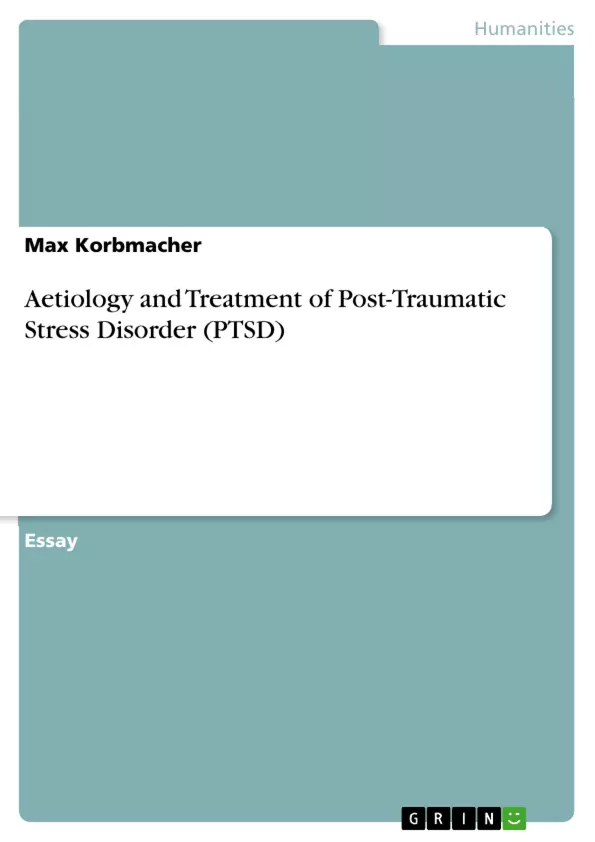A wide range of both common events, such as traffic accidents, and extraordinary events, e.g. rape, can be traumatic. Although processing of traumatic events differs between individuals, it is very likely to be exposed to extreme stressors at some point in life which can lead to PTSD (54-64% in Europe and Japan) making PTSD a common disorder.
This essay will give an overview of the history of the term PTSD, PTSD-prevalence, and the DSM-V diagnosis for individuals older than 6 years. Moreover, aetiology (particularly social, environmental, psychological, and biological vulnerability-factors); and current treatments: Trauma-Focussed Cognitive-Behavioural-Therapy, Eye-Movement-Desensitization-and-Reprocessing, pharmacological/drug-assisted and alternative treatments will be discussed, considering recent psychological theories on PTSD by Foa and Kozak’s (1986) Emotional-Processing-Theory and Ehlers and Clark’s (2000) Cognitive Model of PTSD.
Inhaltsverzeichnis (Table of Contents)
- Aetiology and Treatment of Post-Traumatic Stress Disorder (PTSD)
- History of PTSD
- Prevalence
- DSM-V Diagnosis
- Aetiology
- Social and Environmental Vulnerability Factors
- Psychological Vulnerability Factors
- Genetic and Biological Vulnerability Factors
- Current Treatments
Zielsetzung und Themenschwerpunkte (Objectives and Key Themes)
This essay aims to provide an overview of Post-Traumatic Stress Disorder (PTSD), encompassing its historical context, prevalence rates, and diagnostic criteria outlined in the DSM-V. The essay delves into the aetiology of PTSD, particularly examining social, environmental, psychological, and biological vulnerability factors that contribute to its development. Additionally, the essay explores current treatment approaches for PTSD, including Trauma-Focused Cognitive-Behavioural-Therapy, Eye-Movement-Desensitization-and-Reprocessing, pharmacological/drug-assisted, and alternative treatments.
- Historical development and understanding of PTSD
- Prevalence rates and risk factors associated with PTSD
- The role of social, environmental, psychological, and biological factors in PTSD development
- Various therapeutic approaches for PTSD treatment
- The impact of trauma on individuals' emotional, cognitive, and behavioral responses
Zusammenfassung der Kapitel (Chapter Summaries)
- The essay begins by tracing the historical trajectory of PTSD, highlighting its evolution from early diagnostic terms like "idiotism" to the establishment of PTSD as a distinct mental disorder in the DSM-III in 1980. The impact of events like World War I and the Vietnam War on the recognition and understanding of PTSD is emphasized.
- The essay then delves into the prevalence of PTSD, examining both international and country-specific rates. It discusses how traumatic events such as rape, military combat, and genocide can significantly elevate PTSD rates, particularly in regions experiencing war and conflict.
- The DSM-V criteria for diagnosing PTSD are presented, outlining the key symptom clusters that characterize the disorder. These clusters include persistent re-experiencing of the traumatic event, avoidance of associated stimuli, negative alterations in cognition and mood, and alterations in arousal and reactivity. Dissociative symptoms like depersonalization and derealization are also addressed.
- The essay explores the complex interplay of social, environmental, psychological, and biological factors that contribute to PTSD vulnerability. Social and environmental factors such as socioeconomic status, income, education, minority status, prior trauma, childhood adversity, and age are discussed. The essay also explores the influence of cultural characteristics and the potential for social factors to moderate the course of PTSD.
- Psychological vulnerability factors are examined, including family history of psychopathology, pre-traumatic adjustment problems, and pre-existing mental health conditions. The essay considers the role of coping mechanisms and negative appraisals in influencing vulnerability to PTSD.
- Genetic and biological factors are explored, highlighting the potential influence of gene expressions, intelligence, and gender on PTSD risk. The essay acknowledges that further research is needed to understand the complex interplay of these factors.
Schlüsselwörter (Keywords)
This essay focuses on the complex interplay of factors contributing to the development of Post-Traumatic Stress Disorder (PTSD). Key terms and concepts explored include traumatic events, DSM-V diagnosis, aetiology, social and environmental vulnerability, psychological vulnerability, genetic and biological vulnerability, Trauma-Focused Cognitive-Behavioural-Therapy, Eye-Movement-Desensitization-and-Reprocessing, pharmacological and alternative treatments, emotional processing theory, cognitive model of PTSD, and the impact of trauma on individuals' emotional, cognitive, and behavioral responses.
- Quote paper
- Max Korbmacher (Author), 2018, Aetiology and Treatment of Post-Traumatic Stress Disorder (PTSD), Munich, GRIN Verlag, https://www.grin.com/document/490267



